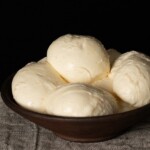Traditional Cultured Mozzarella
Traditional Cultured Mozzarella takes time, but the payoff is well worth it. Made with natural starter cultures and slow fermentation, this mozzarella has a depth of flavor and texture that far surpasses quick acid-set versions. It’s a rewarding process for any home cheesemaker ready to try the real thing.
Servings: 36 servings, about 2 1/4 lbs or 1 kg
Cost: $10
Equipment
- Stockpot
Ingredients
- 2 1/2 gallons Whole Milk 10 Liters
- 100 ml starter clabber, kefir, or whey (1:100), or 1 packet mesophilic starter powder
- 3/4 tsp liquid rennet
- 1 tbsp salt
Instructions
- Bring milk to cheese temperature, about 35°C (95°F).
- Add starter, mix in thoroughly.
- Add rennet, mix in thoroughly.
- Wait for clean break, 45 minutes to 1 hour. Cover the pot to keep in warmth.
- Cut curd to walnut size, 1 inch or 2.5 cm. Cut vertically; cut crosswise; cut horizontally or diagonally.
- Stir curds gently over 5 to 10 minutes.
- Ferment curds under whey at ambient temperature until acidity develops. Goal pH 5.3—stretch test spins. Mozzarella usually takes 6 to 8 hours total to develop its stretch. If the temperature of the curds drops below 30°C (86°F), gently warm curds back up.
- Prepare for mozzarella stretching as curd shows first signs of stretching.
- Bring 5 quarts (about 5 Liters) water to a boil (half as much water as milk).
- Also prepare a 5 quarts (about 5 Liters) cold-water bath.
- Prepare a light salt brine with 2 quarts cold water and 1 Tablespoon salt (brine should taste good!).
- Strain the curds from the whey.
- Pour almost-boiling water over curds until curds melt evenly. Add hot water slowly, stirring curds gently between additions. Add more hot water as needed, but do not overcook.
- Gently bring curds together into a single mass under the water. Shape curds into mozzarella.
- Stretch a handful of curd from the mass into a 6 inch or 15 cm rope.
- Fold rope into an accordion (or roll into a stout pinwheel). Stretch top part of the cheese over the accordion to make a ball. Tear mozzarella off the mass between thumb and forefinger.
- Plunge mozzarella into cold-water bath. Leave in water until cool.
- Transfer mozzarella to light salt brine and refrigerate to preserve.
Notes
Milk Matters: Use the freshest, least processed milk you can find—ideally raw or low-temperature pasteurized and non-homogenized. Cow’s milk is traditional and easy to work with, but buffalo milk gives a creamier, higher-yield cheese if available.
Starter Options: Clabber, kefir, or whey from a previous batch of cultured cheese all work well as natural mesophilic starters. If you're aiming for a quicker make, a thermophilic culture like yogurt can reduce the fermentation time to around 3 hours.
Stretch Window: The key to good mozzarella is hitting the exact moment the curd is ready to stretch. Test a small piece of curd in hot water every 30 minutes once fermentation begins. It should stretch smoothly without breaking—too early and it won't stretch, too late and it becomes crumbly.
Handling Heat: Stretching requires near-boiling water, so have cold water nearby to cool your hands between shaping. Wooden spoons or paddles are essential for stirring and shaping, as metal can stick to the curd.
Brine Tips: A light salt brine helps preserve the finished mozzarella and enhances flavor. Let the cheese cool fully in cold water before transferring it to the brine to maintain its delicate texture.
Recipe Timing
Total Time: About 7 to 10 hours, mostly hands-off during fermentation.- Warm & Inoculate Milk: 10 minutes
- Coagulation (Clean Break): 45 minutes to 1 hour
- Cut & Stir Curds: 10 minutes
- Fermentation Under Whey: 6 to 8 hours (until curd stretches at ~pH 5.3)
- Stretch & Shape: 20 to 30 minutes
- Cool & Brine: 30 minutes
Nutrition
Calories: 160kcal | Carbohydrates: 13g | Protein: 9g | Fat: 8g | Saturated Fat: 5g | Polyunsaturated Fat: 0.3g | Monounsaturated Fat: 2g | Cholesterol: 32mg | Sodium: 294mg | Potassium: 394mg | Fiber: 0.02g | Sugar: 13g | Vitamin A: 426IU | Calcium: 323mg | Iron: 0.002mg
